DC Active Damper Control Strategy Based on Resonance Suppression Effectiveness Evaluation Method
Abstract
:1. Introduction
- (1)
- A resonance suppression criterion is derived by taking the admittance change as variables before and after resonance suppression strategies connected to the system, and a resonance suppression strategy evaluation method is proposed, offering guidance for choosing a more suitable resonance suppression strategy and parameters.
- (2)
- A DC active damper control strategy based on the resonance suppression domain is proposed, achieving targeted admittance reshaping parameter design under different resonance situations.
2. Resonance Suppression Strategy Evaluation Method
2.1. Resonance Suppression Domain of Admittance
2.2. Resonance Suppression Strategy Evaluation
3. The DC Active Damper
3.1. Topology and Control Structure of the DC Active Damper
3.2. Reshape Admittance Design of DC Active Damper Based on a Resonance Suppression Strategy Effectiveness Evaluation Method
4. Simulation Verification
4.1. Resonance Suppression Domain Analysis
4.2. The DC Active Damper Resonance Suppression Effect Verification
5. Conclusions and Discussion
- (1)
- Based on the node impedance before and after the connection of resonance suppression strategies, the proposed resonance suppression effect evaluation method presents the resonance suppression/amplification boundaries directly, avoiding a complicated matrix inverse process. The proposed method is applicable to any type of resonance suppression strategy connected to the system in parallel.
- (2)
- The resonance suppression region boundary appears as a circle that always passes through the origin. The resonance suppression degree is uniformly distributed around the circle and gradually increases with the distance from the circle center. When the node admittance is located within the resonance amplification region, resonance amplification would unavoidably happen on the original or new resonance frequency.
- (3)
- After analyzing the resonance suppression domain distribution and forming corresponding resonance suppression strategy selection guidance, appropriate strategies might also be tough to find considering limits such as the system operation state, difficulty in parameter changes or component additions, etc. In that case, a DC active damper control strategy is proposed, which behaves with strong adaptability under different scenarios. The proposed strategy achieves the targeted design of the active damper control parameters based on the resonance suppression domain distribution, achieving good value in improving resonance suppression efficiency and effectiveness.
Author Contributions
Funding
Conflicts of Interest
References
- Ju, P.; Jiang, T.; Huang, H. Brief discussion on the “three-self” nature of the new power system. Proc. CSEE 2023, 43, 2598–2607. [Google Scholar] [CrossRef]
- Li, B.; Chen, M.; Zhong, H.; Ma, Z.; Liu, D. A review of long-term planning of new power systems with large share of renewable energy. Proc. CSEE 2023, 43, 555–581. [Google Scholar] [CrossRef]
- Jia, K.; Zhao, Q.; Zhu, Z.; Bi, T. Modeling of dc distribution system based on high frequency transient components. IEEE Trans. Smart Grid 2021, 12, 671–679. [Google Scholar] [CrossRef]
- Nuutinen, P.; Pinomaa, A.; Peltoniemi, P.; Kaipia, T.; Karppanen, J.; Silventoinen, P. Common-mode and rf emi in a low-voltage dc distribution network with a pwm grid-tie rectifying converter. IEEE Trans. Smart Grid 2017, 8, 400–408. [Google Scholar] [CrossRef]
- Zong, H.; Zhang, C.; Cai, X.; Molinas, M. Oscillation propagation analysis of hybrid ac/dc grids with high penetration renewables. IEEE Trans. Power Syst. 2022, 37, 4761–4772. [Google Scholar] [CrossRef]
- Mohamad, A.M.I.; Mohamed, Y.A.-R.I. Analysis and mitigation of interaction dynamics in active dc distribution systems with positive feedback islanding detection schemes. IEEE Trans. Power Electron. 2018, 33, 2751–2773. [Google Scholar] [CrossRef]
- Song, W.; Jiao, S.; Li, Y.W.; Wang, J.; Huang, J. High-frequency harmonic resonance suppression in high-speed railway through single-phase traction converter with lcl filter. IEEE Trans. Transp. Electrif. 2016, 2, 347–356. [Google Scholar] [CrossRef]
- Chen, Z.; Huang, X.; Luo, A.; Yang, J.; Yang, L. Wide-band harmonic resonance characteristics and coordinated damping method for distributed generation power plants. IEEE Trans. Ind. Electron. 2019, 66, 7753–7764. [Google Scholar] [CrossRef]
- Ye, Q.; Mo, R.; Li, H. Low-frequency resonance suppression of a dual-active-bridge dc/dc converter enabled dc microgrid. IEEE J. Emerg. Sel. Top. Power Electron. 2017, 5, 982–994. [Google Scholar] [CrossRef]
- Zhan, Y.; Xie, X.; Wang, Y. Impedance network model based modal observability and controllability analysis for renewable integrated power systems. IEEE Trans. Power Deliv. 2021, 36, 2025–2034. [Google Scholar] [CrossRef]
- Wang, C.; Li, W.; Wang, Y.; Meng, Z.; Yang, L. Dc bus voltage fluctuation classification and restraint methods review for dc microgrid. Proc. CSEE 2017, 37, 84–97. [Google Scholar] [CrossRef]
- Liu, F.; Liu, W.; Xu, Y.; Li, Y. Analysis on stability criterion and interaction law of grid-connected inverter control loop under weak grid condition. Proc. CSEE 2023, 43, 466–482. [Google Scholar] [CrossRef]
- Shen, H.; Liu, Z.; Liu, W.; Wang, C.; Sun, X.; Yang, F.; Zhang, M. High frequency resonance analysis and resonance suppression of a grid-connected inverter coupled with a long feeder. IEEE Trans. Power Deliv. 2023, 38, 926–936. [Google Scholar] [CrossRef]
- Pinares, G.; Bongiorno, M. Analysis and mitigation of instabilities originated from dc-side resonances in vsc-hvdc systems. IEEE Trans. Ind. Appl. 2016, 52, 2807–2815. [Google Scholar] [CrossRef]
- Lorzadeh, I.; Abyaneh, H.A.; Savaghebi, M.; Bakhshai, A.; Guerrero, J.M. Capacitor Current Feedback-Based Active Resonance Damping Strategies for Digitally-Controlled Inductive-Capacitive-Inductive-Filtered Grid-Connected Inverters. Energies 2016, 9, 642. [Google Scholar] [CrossRef]
- Wang, H.; Chen, Y.; Wu, W.; Liao, S.; Wang, Z.; Li, G.; Xie, Z.; Guo, J. Impedance Reshaping Control Strategy for Improving Resonance Suppression Performance of a Series-Compensated Grid-Connected System. Energies 2021, 14, 2844. [Google Scholar] [CrossRef]
- Hong, L.; Shu, W.; Wang, J.; Mian, R. Harmonic resonance investigation of a multi-inverter grid-connected system using resonance modal analysis. IEEE Trans. Power Deliv. 2019, 34, 63–72. [Google Scholar] [CrossRef]
- Li, Z.; Hu, H.; Tang, L.; Wang, Y.; Zang, T.; He, Z. Quantitative severity assessment and sensitivity analysis under uncertainty for harmonic resonance amplification in power systems. IEEE Trans. Power Deliv. 2020, 35, 809–818. [Google Scholar] [CrossRef]
- Ren, L.; Guo, H.; Dou, Z.; Wang, F.; Zhang, L. Modeling and Analysis of the Harmonic Interaction between Grid-Connected Inverter Clusters and the Utility Grid. Energies 2022, 15, 3490. [Google Scholar] [CrossRef]
- Guo, Y.; Chen, L.; Lu, X.; Wang, J.; Zheng, T.; Mei, S. Region-based stability analysis for active dampers in ac microgrids. IEEE Trans. Ind. Appl. 2019, 55, 7671–7682. [Google Scholar] [CrossRef]
- Matijevic, E.; Sharma, R.; Zare, F.; Kumar, D. A unified active damping for grid and converter current feedback in active front end converters. IEEE Access 2022, 10, 30913–30924. [Google Scholar] [CrossRef]
- Zhang, H.; Yang, J.; Zhi, N.; Li, N. Stability analysis of dc microgrid based on the passive damping method. High Volt. Eng. 2017, 43, 3100–3109. [Google Scholar] [CrossRef]
- Zhou, L.; Guerrero, J.M.; Zhou, X.; Chen, Y.; Lv, Z.; He, Z.; Wu, W.; Yang, L.; Yan, K.; Luo, A. Inverter-current-feedback resonance-suppression method for lcl-type dg system to reduce resonance-frequency offset and grid-inductance effect. IEEE Trans. Ind. Electron. 2018, 65, 7036–7048. [Google Scholar] [CrossRef]
- Wang, X.; Blaabjerg, F.; Liserre, M.; Chen, Z.; He, J.; Li, Y. An active damper for stabilizing power-electronics-based ac systems. IEEE Trans. Power Electron. 2014, 29, 3318–3329. [Google Scholar] [CrossRef]
- Kim, H.-J.; Kang, S.-W.; Seo, G.-S.; Jang, P.; Cho, B.-H. Large-signal stability analysis of dc power system with shunt active damper. IEEE Trans. Ind. Electron. 2016, 63, 6270–6280. [Google Scholar] [CrossRef]
- Machado, J.E.; Ortega, R.; Astolfi, A.; Arocas-Perez, J.; Pyrkin, A.; Bobtsov, A.A.; Grino, R. An adaptive observer-based controller design for active damping of a dc network with a constant power load. IEEE Trans. Control Syst. Technol. 2021, 29, 2312–2324. [Google Scholar] [CrossRef]
- Wang, X.; Blaabjerg, F.; Liserre, M. An active damper to suppress multiple resonances with unknown frequencies. In Proceedings of the 2014 IEEE Applied Power Electronics Conference and Exposition—APEC 2014, Fort Worth, TX, USA, 16–20 March 2014; pp. 2184–2191. [Google Scholar] [CrossRef]
- Jia, L.; Ruan, X.; Zhao, W.; Lin, Z.; Wang, X. An adaptive active damper for improving the stability of grid-connected inverters under weak grid. IEEE Trans. Power Electron. 2018, 33, 9561–9574. [Google Scholar] [CrossRef]
- Lin, Z.; Ruan, X.; Zhang, H.; Wu, L. A hybrid-frame control based impedance shaping method to extend the effective damping frequency range of the three-phase adaptive active damper. IEEE Trans. Ind. Electron. 2023, 70, 509–521. [Google Scholar] [CrossRef]
- Lin, Z.; Ruan, X. A three-phase adaptive active damper for improving the stability of grid-connected inverters under weak grid. In Proceedings of the 2019 IEEE Applied Power Electronics Conference and Exposition (APEC), Anaheim, CA, USA, 17–21 March 2019; pp. 1084–1089. [Google Scholar] [CrossRef]
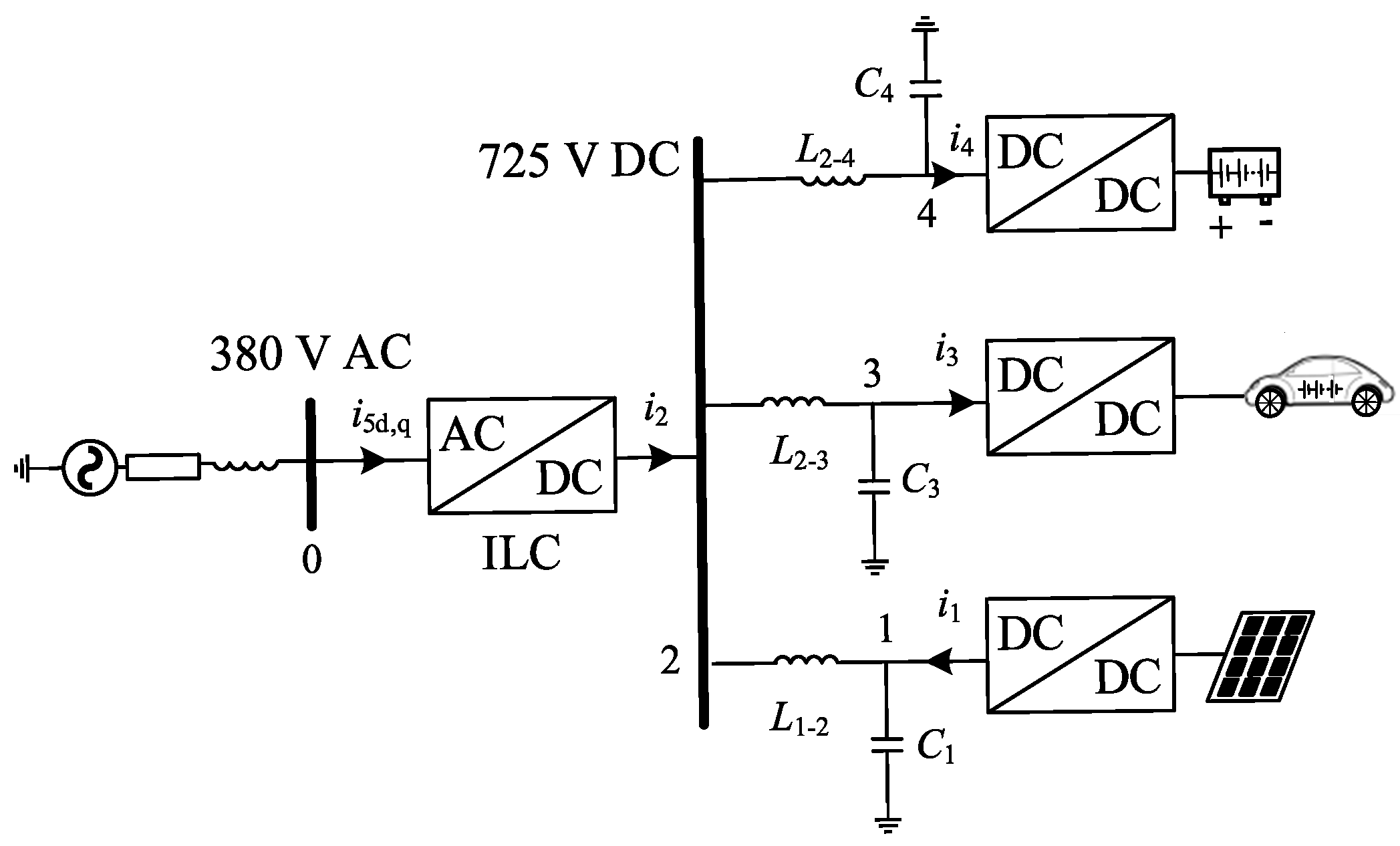
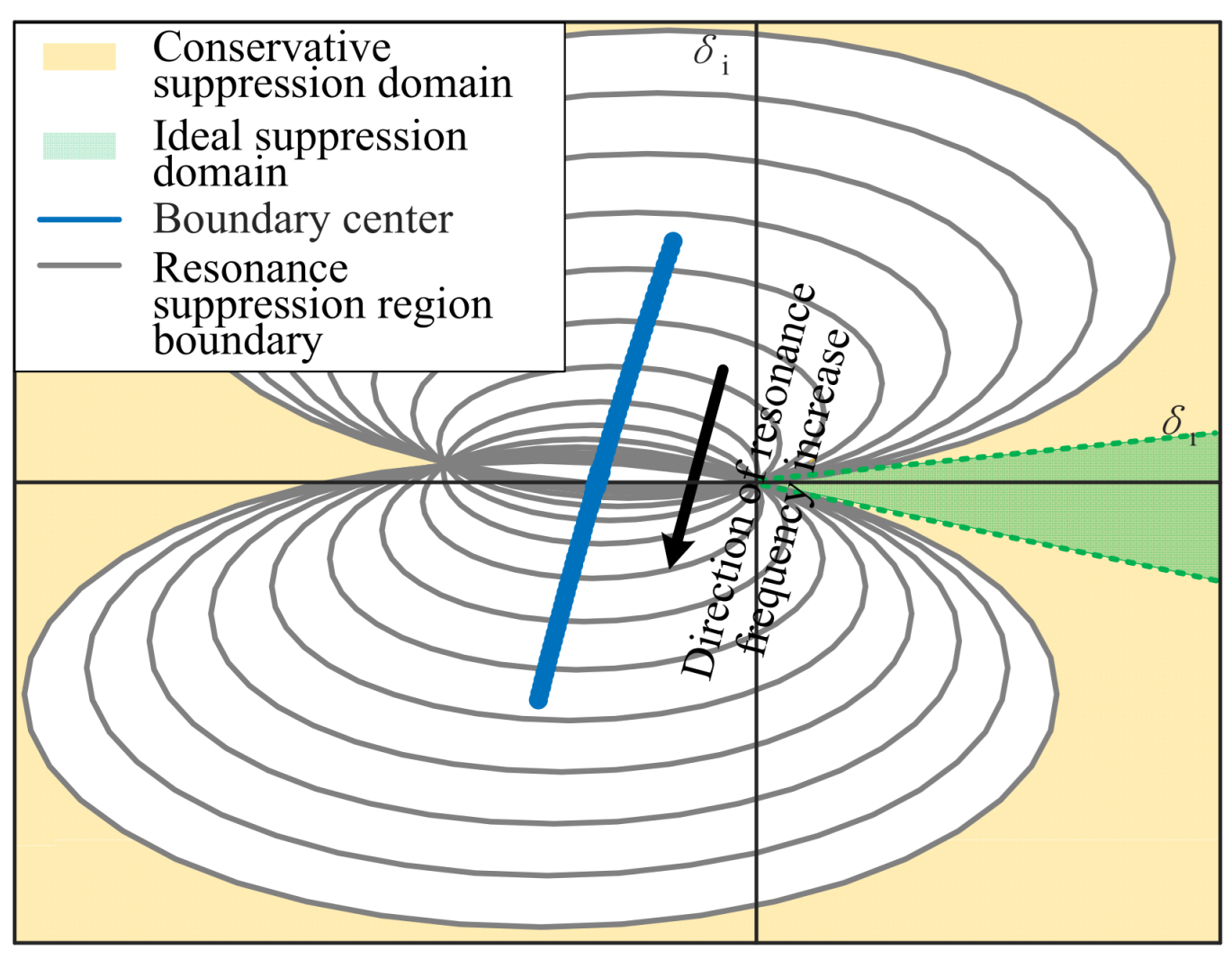


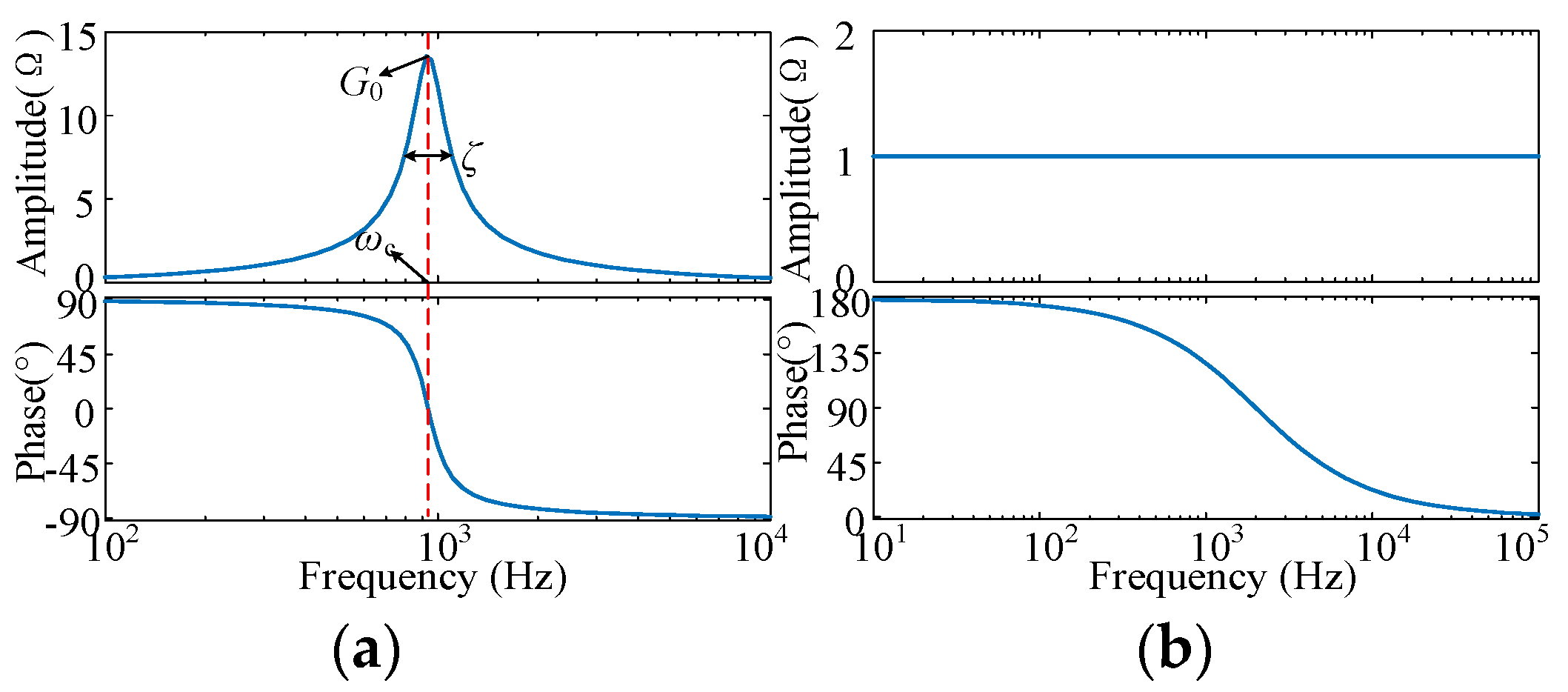
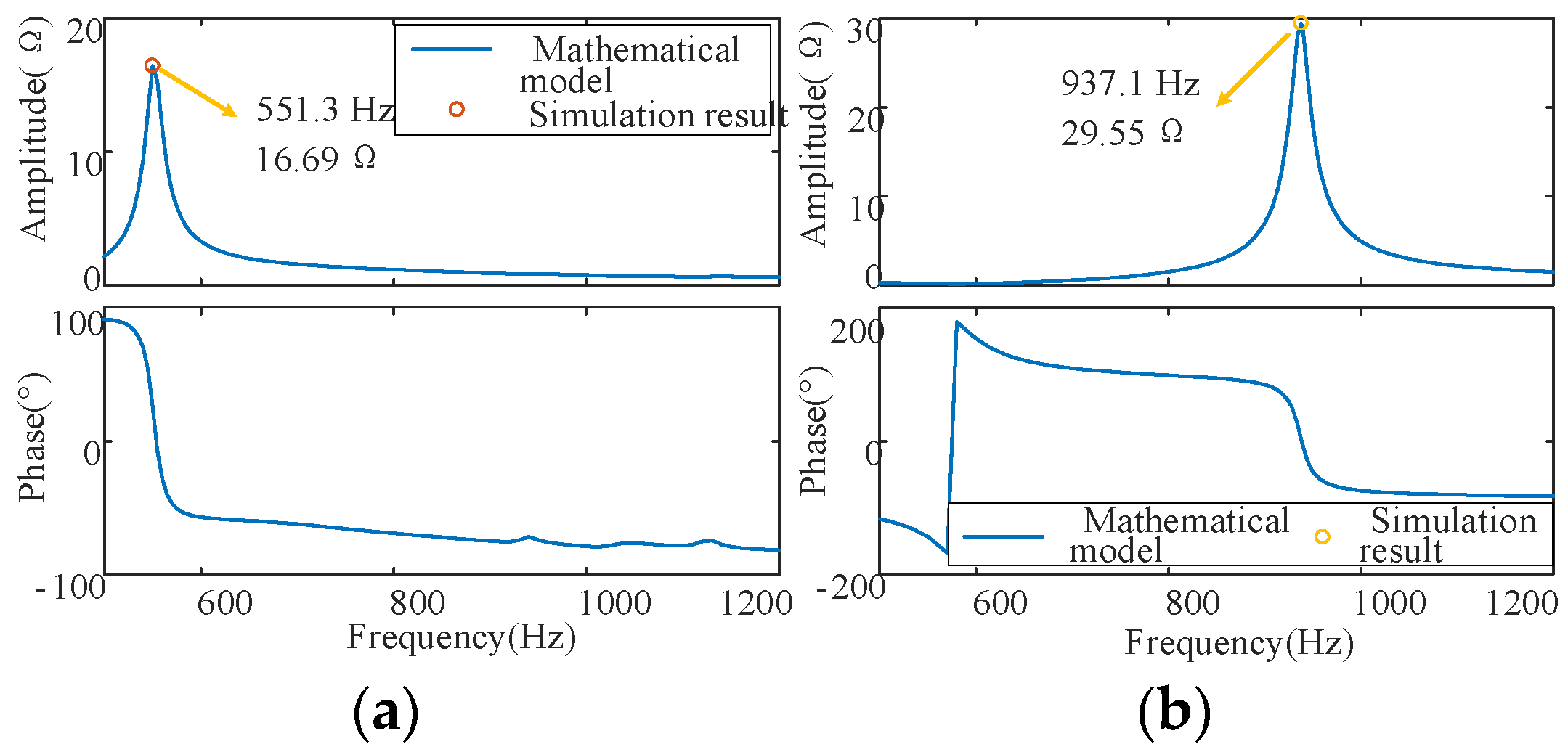
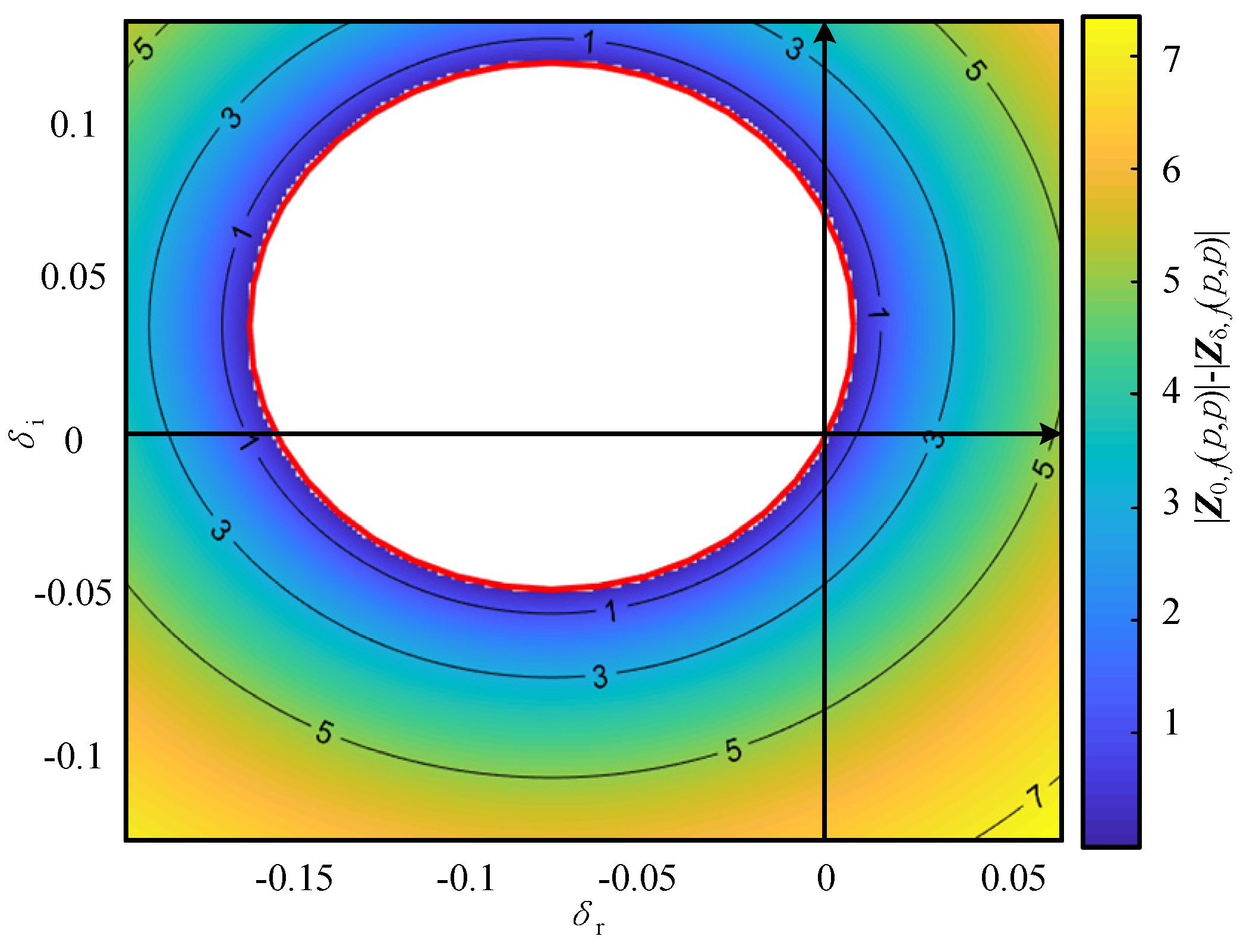


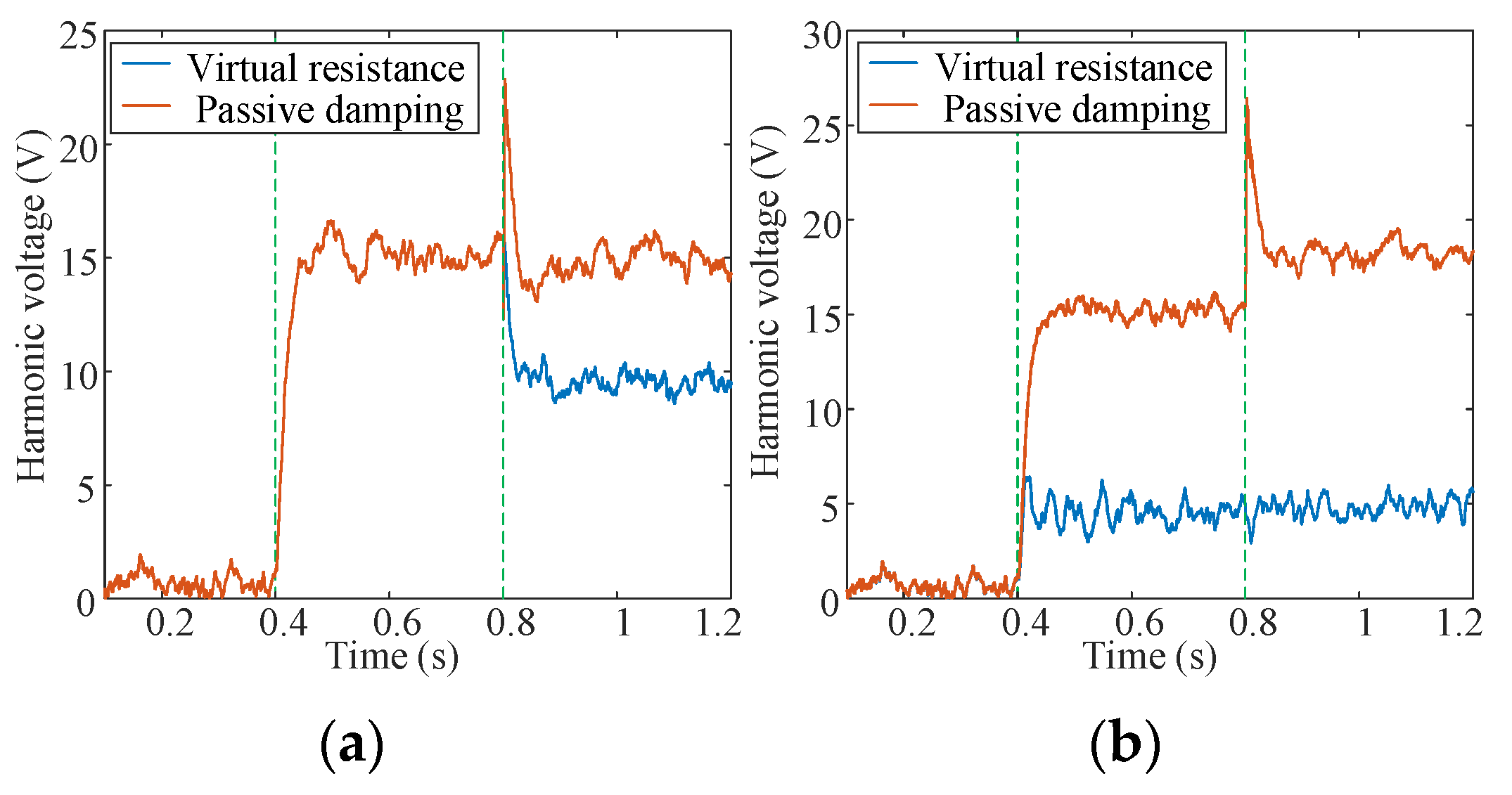



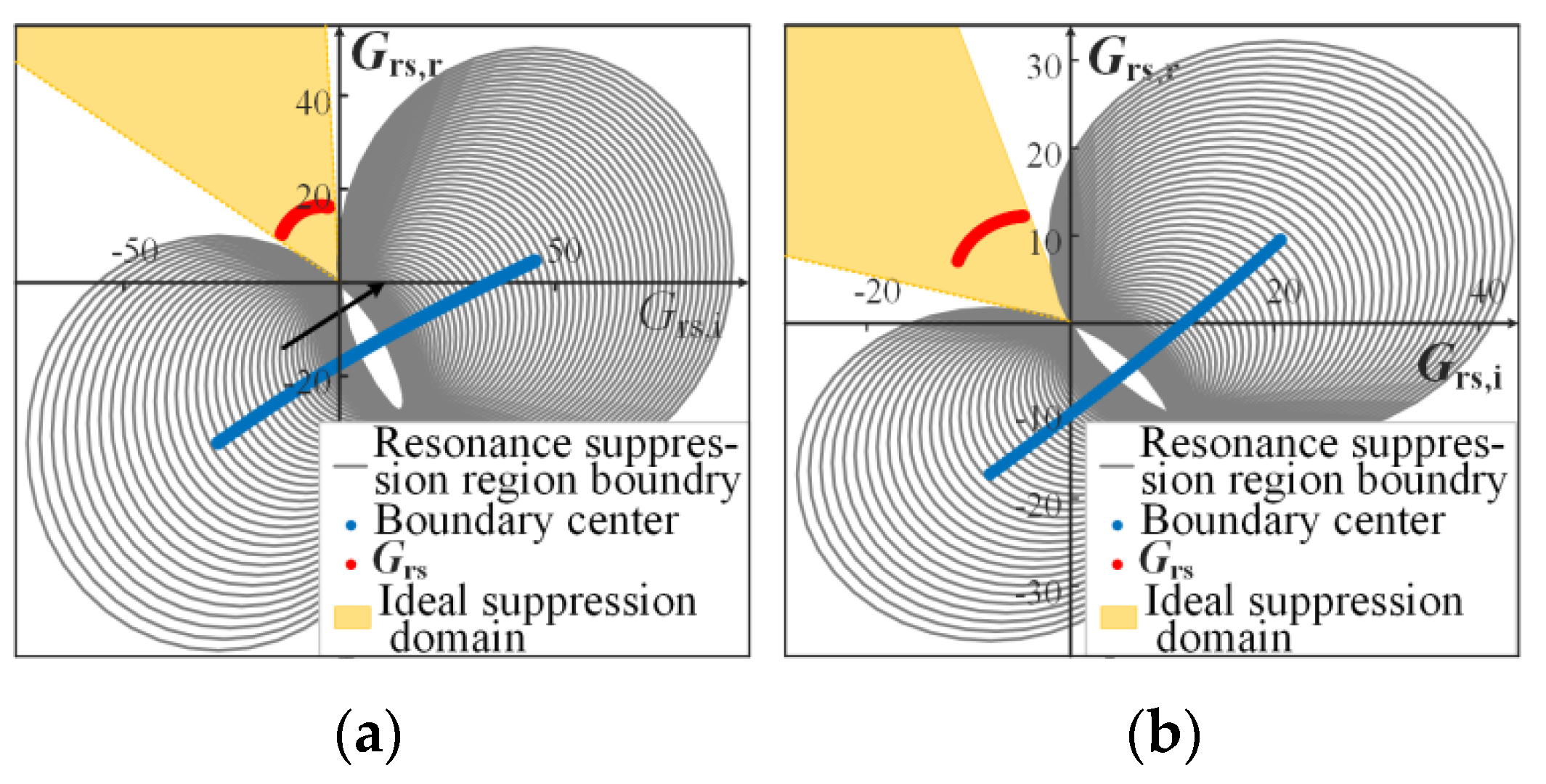

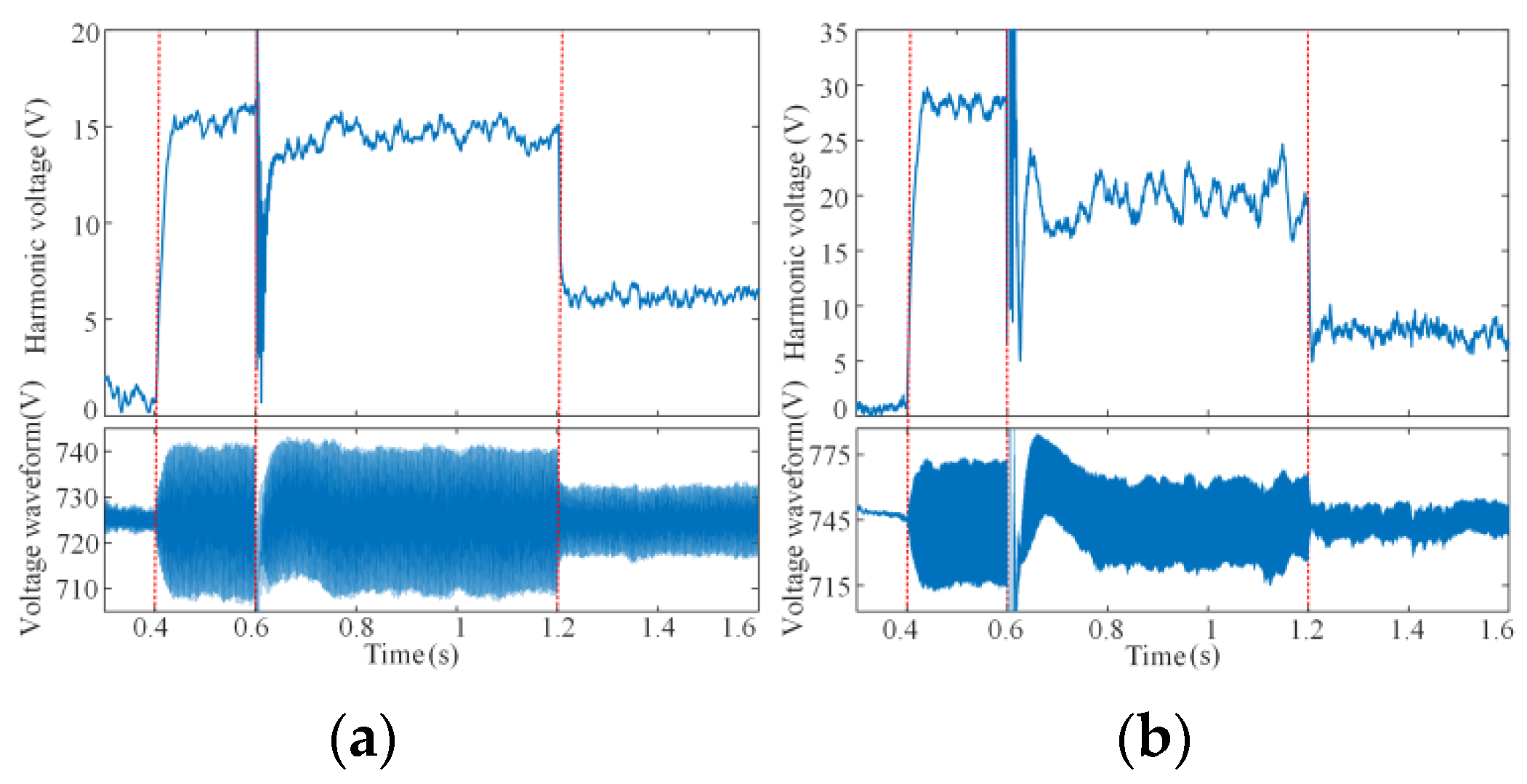

| Parameter | Value | Parameter | Value |
|---|---|---|---|
| L1-2 | 3 mH | P1 (Distributed power source in node 1) | 10 kW |
| C1 | 500 μF | P2 (Load converter in node 3) | 15 kW |
| L2-3 | 0.5 mH | P3 (Load converter in node 4) | 15 kW |
| C3 | 3000 μF | P6(ILC) | 20 kW |
| L2-4 | 0.6 mH | P7 (The injected power of node 0) | 18 kW |
| C4 | 400 μF | Uref,DC | 725 V |
| Base frequency | 50 Hz |
| Resonance Frequency | Zdc-dc | |
|---|---|---|
| Node | Maximum Value | |
| 551.3 Hz | Z(i,j) i, j = 1,4 | Z(2,2) 16.69 Ω |
| 937.1 Hz | Z(1,j), Z(i,1) i, j = 1,4 | Z(1,1) 29.51 Ω |
| Parameter | Value | Parameter | Value |
|---|---|---|---|
| Cdc | 1500 μF | f0 | 50 Hz |
| Udc | 750 V | kp1 | 20 |
| P | 2 kW | ki1 | 333.33 |
| Cf | 50 μF | kp2 | 1.5 |
| Lf | 3 mH | ki2 | 0.05 |
| Switching frequency | 20 kHz |
| G0 | ωc | ζ | T | |
|---|---|---|---|---|
| 551.3 Hz | 7 | 2π × 551.3 | 0.2 | 1.60 × 10−4 |
| 937.1 Hz | 3 | 2π × 937.1 | 0.11 | 8.00 × 10−5 |
Disclaimer/Publisher’s Note: The statements, opinions and data contained in all publications are solely those of the individual author(s) and contributor(s) and not of MDPI and/or the editor(s). MDPI and/or the editor(s) disclaim responsibility for any injury to people or property resulting from any ideas, methods, instructions or products referred to in the content. |
© 2024 by the authors. Licensee MDPI, Basel, Switzerland. This article is an open access article distributed under the terms and conditions of the Creative Commons Attribution (CC BY) license (https://creativecommons.org/licenses/by/4.0/).
Share and Cite
Zhang, H.; Wang, Y.; Zhu, X.; Xu, Y.; Tao, S. DC Active Damper Control Strategy Based on Resonance Suppression Effectiveness Evaluation Method. Energies 2024, 17, 480. https://doi.org/10.3390/en17020480
Zhang H, Wang Y, Zhu X, Xu Y, Tao S. DC Active Damper Control Strategy Based on Resonance Suppression Effectiveness Evaluation Method. Energies. 2024; 17(2):480. https://doi.org/10.3390/en17020480
Chicago/Turabian StyleZhang, Huaying, Yingxin Wang, Xinyi Zhu, Yonghai Xu, and Shun Tao. 2024. "DC Active Damper Control Strategy Based on Resonance Suppression Effectiveness Evaluation Method" Energies 17, no. 2: 480. https://doi.org/10.3390/en17020480





